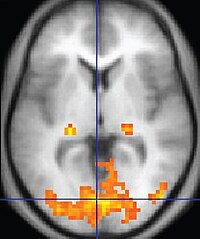
Photo from wikipedia
Narrow-band imaging (NBI) is an optical technique enhancing mucosal vasculature. The aim of this study is to assess the effectiveness of rigid NBI endoscopy in the early detection of second… Click to show full abstract
Narrow-band imaging (NBI) is an optical technique enhancing mucosal vasculature. The aim of this study is to assess the effectiveness of rigid NBI endoscopy in the early detection of second primaries or local recurrences after treatment for oral (OSCC) and oropharyngeal squamous cell carcinoma (OPSCC), its advantage over standard white-light (WL) endoscopy, and the influence of previous radiotherapy, the learning curve, and lesion site. Between January 2013 and June 2015, 195 patients treated for OSCC or OPSCC with surgery alone (group A) or radiotherapy with or without surgery and/or chemotherapy (group B) underwent additional follow-up assessments using NBI. Sensitivity, specificity, positive/negative predictive values (PPV and NPV), and accuracy for detecting second primaries or local recurrences were calculated for patients with at least two NBI assessments. The effect of previous radiotherapy was determined by test of proportions and that of the learning curve and lesion site with Fisher’s exact test. 138/195 patients were included in the analysis. NBI sensitivity, specificity, PPV, NPV, and accuracy for groups A and B were 89.5 vs 100%, 85.2 vs 81.5%, 65.4 vs 69.7%, 96.3 vs 100%, and 86.3 vs 87%, respectively. The diagnostic gain of NBI was 88.2% in group A and 69.6% in group B. The learning curve was the main source of false positives (p = 0.025), whereas radiotherapy and lesion site were uninfluential (p = NS). NBI appears useful for follow-up after treatment for OSCC or OPSCC, its performance being affected only by the learning curve and not by previous treatment or lesion site.
Journal Title: European Archives of Oto-Rhino-Laryngology
Year Published: 2017
Link to full text (if available)
Share on Social Media: Sign Up to like & get
recommendations!